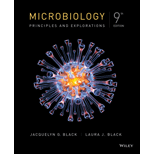
Microbiology: Principles and Explorations
9th Edition
ISBN: 9781118743164
Author: Jacquelyn G. Black, Laura J. Black
Publisher: WILEY
expand_more
expand_more
format_list_bulleted
Concept explainers
Textbook Question
Chapter 7, Problem 1.1SC
Compare and contrast chromosomes in prokaryotes and cukaryotes
Expert Solution & Answer
Summary Introduction
To contrast: The chromosomes in prokaryotes and eukaryotes.
Introduction: The deoxyribonucleic acid (DNA) is the hereditary material that transmits the genetic information from one generation to the next generation. It consists of two strands of polynucleotide chains that are wind around each other to form double helix. It is composed of nucleotides, sugar, and phosphate.
Explanation of Solution
The chromosomes are the threadlike structure that are found in the nucleus and contains hereditary material in the form of genes. The difference between the chromosomes of prokaryotes and eukaryotes are described as follows:
| Chromosomes in prokaryotes | Chromosomes in eukaryotes |
|
|
|
|
|
|
|
|
|
|
Want to see more full solutions like this?
Subscribe now to access step-by-step solutions to millions of textbook problems written by subject matter experts!
Students have asked these similar questions
Compare the number and structure of chromosomesin prokaryotes and eukaryotes.
Which statement below correctly describes a key difference between prokaryotic and eukaryotic chromosome structure?
O a. Prokaryotes possess dsDNA, whereas eukaryotes possess ssDNA
O b. Prokaryotes do not possess DNA, whereas eukaryotes do
O c. Prokaryotic DNA is circular, whereas eukaryotic DNA is linear
O d. Prokaryotic DNA is found in the nucleus, whereas eukaryotic DNA is found in the nucleoid
O e. None of the above
Describe the process of DNA replication as it occurs in prokaryoticcells.
Chapter 7 Solutions
Microbiology: Principles and Explorations
Ch. 7 - Compare and contrast chromosomes in prokaryotes...Ch. 7 - DNA is not always the gemetic material. What are...Ch. 7 - How could mutations give rise to new alleles of a...Ch. 7 - How does trandlation differ from transcription?Ch. 7 - Distinguish between leading and lagging strands.Ch. 7 - What do 5 and 3 refer to? How do they determine...Ch. 7 - Contrast the three kinds of RNA. Does DNA make all...Ch. 7 - What feeds back in feedback inhibition? What does...Ch. 7 - What is the inducer for the lac operon?Ch. 7 - Compare enzyme induction and enzyme repression.
Ch. 7 - If you had be exposed to a mutagen,would you...Ch. 7 - How can a change in geneotype fail to produce a...Ch. 7 - Why are nitrates and nitrites, which have been...Ch. 7 - Cathy develops a painful cluster of blister-like...Ch. 7 - Prokaryotes usually have just one chromosome and...Ch. 7 - During the early stages of development of the...Ch. 7 - Suppose you are a medical technician working in a...Ch. 7 - Match the following terms with their descriptions:Ch. 7 - Prob. 2SQCh. 7 - Prob. 3SQCh. 7 - Match the following terms with their respective...Ch. 7 - From the DNA template sequence 3-ATGCAGTAG-5, what...Ch. 7 - What type of RNA carries and transfers amino acids...Ch. 7 - What type of RNA carries the genetic information...Ch. 7 - Which of the following statements does not...Ch. 7 - Prob. 9SQCh. 7 - For the lac operon, match the following:Ch. 7 - Prob. 11SQCh. 7 - A frameshift mutation occurs following the: (a)...Ch. 7 - Prob. 13SQCh. 7 - Which of the following schemes for molecular...Ch. 7 - Suppose a point mutation occurred in the third...Ch. 7 - Prob. 16SQCh. 7 - (a) Why are bacteria useful in the study of...Ch. 7 - DNA damage in the form of dimers induced by UV...Ch. 7 - Prob. 19SQCh. 7 - Name and describe the effects of the following...
Knowledge Booster
Learn more about
Need a deep-dive on the concept behind this application? Look no further. Learn more about this topic, biology and related others by exploring similar questions and additional content below.Similar questions
- Describe the difference between a prokaryote nucleoidand a eukaryote nucleus.arrow_forwardNote : — don't copy in google or bartleby. Plagarize checker will be used. QUESTION : In a tabular form, compare the differences of prokaryotic and eukaryotic cells.arrow_forwardCompare and contrast the prokaryotic and eukaryotic cells by constructing a table of similarities and differences. Explain in 1-3 sentences onlyarrow_forward
- Give typing answer with explanation and conclusion Eukaryotic chromosomes are composed by __________ molecules associated with proteins, mostly some __________ proteins called _________. A) RNA, acidic, gamma-globulins B) DNA, acidic, phosphatases C) DNA, basic, histones D) RNA, neutral, kinasesarrow_forwardProkaryotes contain a ______ chromosome, and eukaryotes contain ________ chromosomes. a. single-stranded circular; single-stranded linear b. single-stranded linear: single-stranded circular c. double-stranded circular; double-stranded linear d. double-stranded linear; double-stranded circulararrow_forwardShow the diagram for DNA replication of prokaryotes.arrow_forward
- Make a list of the differences between eukaryote and prokaryote cells.arrow_forwardCopy the Venn Diagram and use the word bank to fill it out Eukaryotic Cell Prokaryotic Cel Word bank Simple Cell Complex Cell -No nucleuS Nucleus -Cell Membrane -DNA -Ribosomes Membrane-bou nd Organelles -bacteria animal/plant cellsarrow_forwardCompare and contrast cellular characteristics of prokaryotes and eukaryotes.arrow_forward
arrow_back_ios
SEE MORE QUESTIONS
arrow_forward_ios
Recommended textbooks for you
 Concepts of BiologyBiologyISBN:9781938168116Author:Samantha Fowler, Rebecca Roush, James WisePublisher:OpenStax College
Concepts of BiologyBiologyISBN:9781938168116Author:Samantha Fowler, Rebecca Roush, James WisePublisher:OpenStax College

Concepts of Biology
Biology
ISBN:9781938168116
Author:Samantha Fowler, Rebecca Roush, James Wise
Publisher:OpenStax College
Biology - Intro to Cell Structure - Quick Review!; Author: The Organic Chemistry Tutor;https://www.youtube.com/watch?v=vwAJ8ByQH2U;License: Standard youtube license